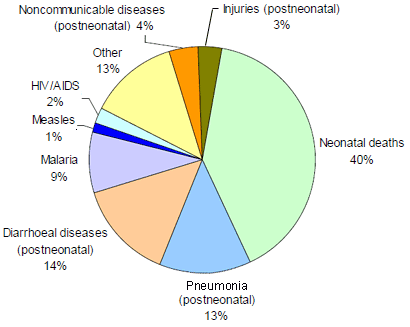Children: reducing mortality
Key facts
- 7.6 million children under the age of five die every year, according to 2010 figures.
- Over two-thirds of these early child deaths are due to conditions that could be prevented or treated with access to simple, affordable interventions.
- Leading causes of death in under-five children are pneumonia, diarrhoea, malaria and health problems during the first month of life.
- Over one third of all child deaths are linked to malnutrition.
- Children in low-income countries are nearly 18 times more likely to die before the age of five than children in high-income countries.
A child's risk of dying is highest in the neonatal period, the first 28 days of life. Safe childbirth and effective neonatal care are essential to prevent these deaths. About 40% of child deaths under the age of five take place during the neonatal period.
Preterm birth, birth asphyxia (lack of breathing at birth), and infections cause most neonatal deaths. From the end of the neonatal period and through the first five years of life, the main causes of death are pneumonia, diarrhoea and malaria Malnutrition is the underlying contributing factor in over one third of all child deaths, making children more vulnerable to severe disease.
Major causes of death in neonates and children under five globally - 2008

Source: World Health Statistics 2011, WHO
Who is most at risk?
Geographically
Over 70% of all child deaths occur in Africa and South-East Asia. Within countries, child mortality is higher in rural areas, and among poorer and less educated families.
Neonates
More than three million babies die every year in their first month of life and a similar number are stillborn. Within the first month, one quarter to one half of all deaths occur within the first 24 hours of life, and 75% occur in the first week. The 48 hours immediately following birth is the most crucial period for newborn survival. This is when the mother and child should receive follow-up care to prevent and treat illness.
Prior to birth, the mother can increase her child's chance of survival and good health by attending antenatal care consultations, being immunized against tetanus, and avoiding smoking and use of alcohol.
At the time of birth, a baby's chance of survival increases significantly with the presence of a skilled birth attendant. After birth, essential care of a newborn should include:
- ensuring that the baby is breathing;
- starting the newborn on exclusive breastfeeding right away;
- keeping the baby warm; and
- washing hands before touching the baby.
Identifying and caring for illnesses in a newborn are also very important, as a baby can become very ill and die quickly if an illness is not recognized and treated appropriately. Sick babies must be taken immediately to a trained health care provider.
Children under age five
Over two thirds of under-five child deaths are due to diseases that are preventable and treatable through simple, affordable interventions. Strengthening health systems to provide such interventions to all children will save many young lives.
In 2010 about 20 million children worldwide were estimated to suffer from severe acute malnutrition, leaving them more vulnerable to serious illness and early death. Most of these children can be successfully treated at home with ready-to-use therapeutic foods (RUTF). Globally, in 2010, an estimated 171 million children below five years of age, were stunted and 104 million were underweight. Optimal breastfeeding and complementary feeding help prevent malnutrition and can save about a million child lives.
Leading causes of death in children: risk factors and response
Cause of death Risk factors Prevention Treatment
Pneumonia, or other Low birth weight Vaccination Appropriate care by a
acute respiratory Malnutrition Adequate nutrition trained health provider
infections Non-breastfed children Exclusive breastfeeding Antibiotics
Overcrowded conditions Oxygen for severe illness
—————————————————————–———————————————————
Childhoohd diarrhoea Non-Breastfed children Exclusive breastfeeding Low-osmolarity oral rehydration salts (ORS)
Unsafe drinking water Safe water and food
and food Adequate sanitation and
hygiene Zinc supplements
Poor hygiene practices Adequate nutrition
Malnutrition Vaccination
Prevention with vaccines
For some of the most deadly childhood diseases, such as measles, polio, diphtheria, tetanus, pertussis, pneumonia due to Haemophilius influenzae type B and Streptococcus pneumoniae and diarrhoea due to rotavirus, vaccines are available and can protect children from illness and death.
(Source: WHO Fact sheet N°178)
